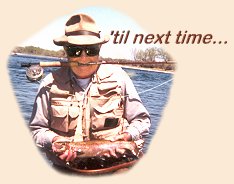
| ||
|
October 6th, 2003
|
|
Q. From Claudia S.: I would like to ask you where are most mayfly nymphs found in freshwater rivers, in the middle or edges? Also is the middle of the river faster than the edge? And if so will it have more dissolved oxygen? And will this enable a greater population of mayfly nymphs? Also is the depth of the river greatest at the middle or edge? And does the depth affect the velocity and number of mayfly nymphs? Your help is much appreciated. Many thanks.
A.
Claudia, you've asked several questions having to do
with two general themes: (1) river channel shape and
form (geomorphology) and (2) distribution of mayfly
nymphs. I'll address your questions under these
themes and hope to answer your questions.
River channel geomorphology: A natural, meandering
river exhibits several characteristics pertaining to
depth, current velocity, and channel form. A line
connecting the deepest points along a river channel
is called the thalweg. Now this line can shift
back and forth as the channel meanders; where the
channel swings against a cut bank, the thalweg is
closer to the bank than to the middle of the channel.
In a straight section of the channel, the thalweg is
usually near the center of the channel. Thus, the
deepest part of the channel shifts back and forth
as the river meanders; it is deepest near the edge
on the outside of a curve, shallowest on the inside
of the curve, and deepest, usually, in the middle on
a straight reach. Current velocity is generally greatest
along the thalweg because there is less drag (friction)
of the entire water column against the bottom where it
is deepest. In most average size streams and rivers,
dissolved oxygen will not vary much from side to side;
the mixing of the water as it tumbles over rocks ensures
adequate exchange of oxygen with the air and within the
water column.
I've only generalized for a couple of situations above;
to go into more detail would take an undue amount of space.
If you'd like to pursuer this further with more specific
questions, please feel free to contact me.
|
| If you would like to comment on this or any other article please feel free to post your views on the FAOL Bulletin Board! |
[ HOME ]
[ Search ] [ Contact FAOL ] [ Media Kit ]
 The 'Stream Doctor' is a retired professional stream ecologist and
author, now living in the West and spending way too much time
fly-fishing. You are invited to submit questions relating to
anything stream related directly to him for use in this Q & A Feature
at
The 'Stream Doctor' is a retired professional stream ecologist and
author, now living in the West and spending way too much time
fly-fishing. You are invited to submit questions relating to
anything stream related directly to him for use in this Q & A Feature
at